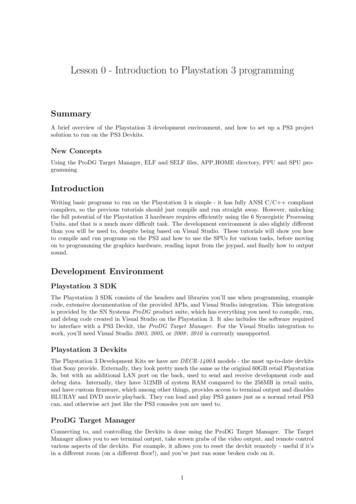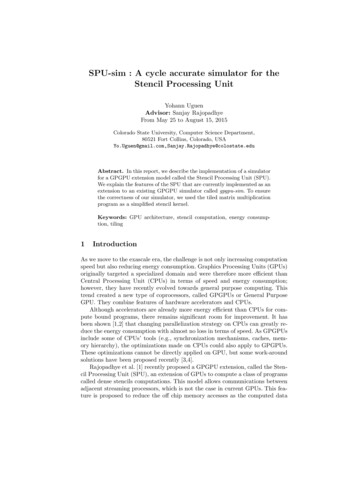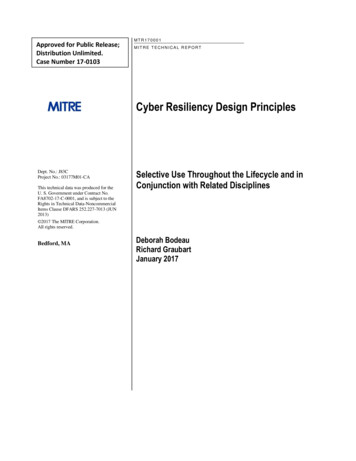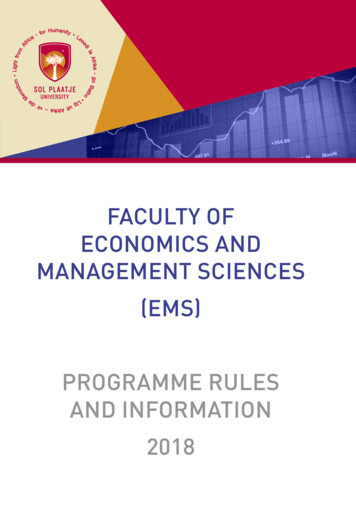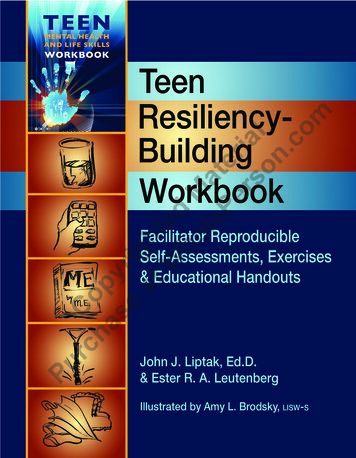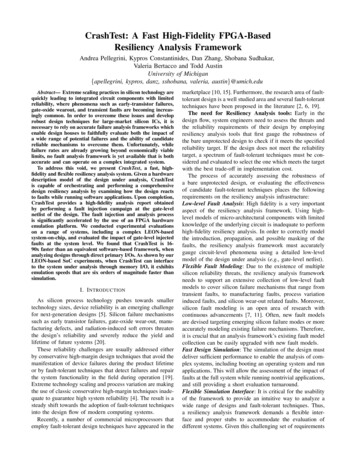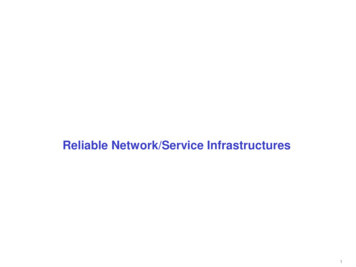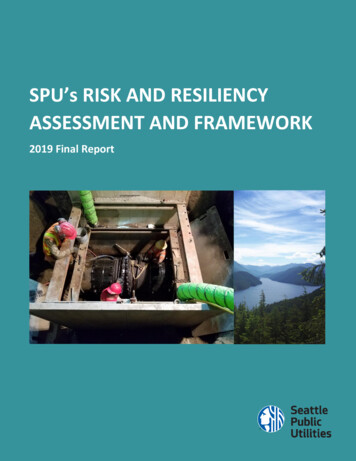
Transcription
SPU’s RISK AND RESILIENCYASSESSMENT AND FRAMEWORK2019 Final Report2019 SPU RISK AND RESILIENCY ASSESSMENT AND FRAMEWORK - 1SeattlePublicUtilities
Table of ContentsPageSection3Section 1: Introduction7Section 2: Climate Change12Section 3: Disasters17Section 4: Investment Priorities21Section 5: Economy24Section 6: Market Forces26Section 7: Technology28Section 8: Workforce31Section 9: Next Steps32Appendix A: Impact-Likelihood Matrix2019 SPU RISK AND RESILIENCY ASSESSMENT AND FRAMEWORK - 2
Section 1: IntroductionOrganizations today are faced with multiple risks and uncertainties as they work to fulfill their missions. Beingresilient offers a powerful way of addressing risks comprehensively, managing uncertainty, and taking advantageof new opportunities. For Seattle Public Utilities (SPU), resiliency is the capacity to recover in the face of sudden orgradual stressors that impact utility services and the community.SPU delivers essential water, drainage and wastewater, and solid waste services – all fundamental for public andenvironmental health. Seattle has been a leader in making utility investments that have multiple, long-termcommunity benefits. After the Great Seattle Fire of 1889, the citizens of Seattle voted to create a public watersystem and develop the Cedar River water supply system. Seattle’s water, drainage, wastewater, and solid wasteutilities have faced many challenges over the years and have evolved to improve services and reduce pollutionimpacts. As a community-centered utility, SPU seeks to proactively address community needs and risks to improveresiliency.In 2017, Seattle City Council requested that SPU“prepare a risk and resiliency managementassessment.” SPU delivered the status report toCouncil on August 1, 2018. This final report detailsrisks to SPU and provides examples of ongoing effortsto be resilient, equitable, and affordable. Sections 2-8provide descriptions of various risks and SPU’sprogress in addressing those risks. Section 9 describesSPU’s next steps to advance this work throughout theutility to best serve the community.SPU faces a variety of challenges: a changing climate,the threat of natural disaster, technological advances,inequity, economic variability, competition, and anaging workforce. In order to be resilient, SPU needsto look to the future and be positioned to adapt torisks and opportunities as they arise. SPU hasSchool visit to the watersheddeveloped a comprehensive risk and resiliencyframework that includes the broad areas of operational and strategic risks. This framework helps SPU to assessvulnerabilities, identify new risks, and develop strategies and solutions that support utility and communityresiliency. SPU’s goal is to optimize utility investments that address multiple risks at the same time.In accordance with the City of Seattle’s Race and Social Justice Initiative, risk and resiliency strategies will strive toaddress systemic and institutional racism and will direct attention to disadvantaged communities. SPU recentlyconducted a series of Racial Equity Toolkit meetings with subject matter experts from across the utility. Thesemeetings helped SPU to identify and develop responses to the disparate impacts these risks can have onvulnerable communities. The aim of this ongoing work is to embed the equity lens within the risk and resiliencyframework and utility plans.2019 SPU RISK AND RESILIENCY ASSESSMENT AND FRAMEWORK - 3
Planning IntegrationSPU is working directly with lines of business to connect this work to their policies, programs, projects,comprehensive and capital plans, and daily operations. The risk and resiliency framework is being incorporatedinto the Solid Waste Comprehensive Plan amendment and the Drainage & Wastewater Integrated System Plan.SPU’s Strategic Business Plan will also incorporate risk and resiliency as one of the main priorities for the utility.SPU is working with a variety of federal and state agencies, community partners, and tribes, and has shared thiswork with the Community Advisory Committee and the Customer Review Panel. The risk and resiliency frameworkintegrates with other efforts such as the City of Seattle’s Resilience Strategy and the All-Hazards Mitigation Plan aswell as King County’s Wastewater Treatment Division’s Resiliency and Recovery Program. SPU is also working withthe Environmental Protection Agency on the best way to develop resilient stormwater infrastructure in responseto regulations. As the diagram below shows, partnerships are critical to fostering resilient utility services thatsupport the whole community.Agencies (EPA)State Agencies (DOH, DOE)Corporate Policy AlignmentIndustry O rganizat ions(WaterRF, AWWA, NACWA)Strategic Business PlanFleets Master PlanRace and Social Justice InitiativeSecurity Master PlanCity Departments(OSE, SCL, OEM, SOOT, O PCD)ResiliencyKi ng County WTDResiliency and Recovery ProgramFacilit ies Master PlanWate r System PlanSolid Waste Comp PlanCommunity Advisory CommitteesCustomer Review PanelHuman Resources PlanDWW Integr ated System PlanTribesGoal StatementThe risk and resiliency goal statement serves to guide how SPU applies its risk and resiliency framework topolicies, programs, plans, projects, and operations. To make “no-regrets” investments in infrastructure, operations, and people that improve SPU’s ability toprovide critical utility services in the face of future disruptions, changes, and opportunities.2019 SPU RISK AND RESILIENCY ASSESSMENT AND FRAMEWORK - 4
Risk Focus AreasThe table below shows the seven strategic risk areas SPU has identified. Sections 2-8 address these focus areasand provide a description of the risks as well as SPU’s accomplishments in addressing these ity tosite facilitiesEmergingand changingsystemsInstitutionalknowledge lossTerrorismProjects andprogramsinitiated byothersPopulationgrowthAvailabilityof rawmaterialsIndependentsystemsSkill availabilityanddevelopmentSea level riseCyberattackAging,substandardinfrastructureand facilitiesLoss ofcustomersand revenuesRecyclingmarkets andrevenuesNewtreatmenttechniquesRetention andturnoverWildfiresDam failureAir rioritiesCost of debtMarketplacecompetitionHigh windsPlanning ProcessSPU has developed a risk and resiliency planning process that brings together the assessment and management ofboth operational and strategic risks. SPU has had an operational risk framework since 2004. Programs, such assafety, security, and claims, are examples of ways that SPU manages operational risks. SPU also has beenassessing and managing long-term, strategic risks, such as climate change and disasters. The following diagramshows SPU’s planning process to comprehensively manage risk.2019 SPU RISK AND RESILIENCY ASSESSMENT AND FRAMEWORK - 5
Risks (Integrating Race and Social Justice)ENVIRONMENTALPublic Trust,,WorkforceSafetyEnvironmental----IIIIII RISKIDENTIFICATIONrAsset & Service Reliability,, ,,,,,,.I,, LegalFinancial, ,,III-- Technology Adaptation. , '\I IADAPTIIIIII RISK RANKINGPRIORITIZING IIII\IIII\IIII \',STRATEGICPLANNINGADAPT1 \',I,'','' --------------- ----------'---------------'--------' Public OpinionWorkforce\I 'SecurityAffordabilityDisastersClimate ChangeRegional PrioritiesTechnological ChangeEconomy,Regulatory ChangeBrief Description for the Risk and Resiliency Planning Process:1. Risk Identification – Identify risks within SPU and the industry.2. Future Casting and Data Analysis – Develop and manage data, models, and scenarios that will assist inplanning for a variety of possible futures.3. Risk Ranking and Prioritization – Rank risks according to established measures and determine howthis informs the prioritization of various bodies of work.4. Options Analysis – Identify risk reduction options and assess cost-benefit, affordability, and impacts tovulnerable communities.5. Strategic Planning – Determine how best to carry out and integrate selected options by exploringpartnering, phasing, and additional planning.6. Implementation – Plan how to initiate projects and programs, making sure they are incorporated intoongoing efforts.7. Monitoring – Track the change in risk status and the effectiveness of strategies and controls.8. Adaptation – Make changes as needed by returning to relevant steps in the planning process.2019 SPU RISK AND RESILIENCY ASSESSMENT AND FRAMEWORK - 6
Section 2: Climate ChangeGlobal warming puts more energy into the earth’satmosphere, which results in rising temperatures,changing weather patterns, more powerfulstorms, and melting ice caps and glaciers. Thewater cycle is particularly impacted. In the past,infrastructure engineers could assume, for themost part, that the future would conform tohistorical trends; now there is increasinguncertainty. Puget Sound climate patterns arechanging and are expected to continue to do so inthe coming decades. Climate change is impactinginfrastructure systems, staff, and the communitiesSPU serves. SPU is a leader in assessing andworking to adapt to a changing climate.EPADroughtDescription: SPU’s water supply system historically relies on snowpack as a means of additional storage to meetdemands during dry summer months. Snowmelt is more predictable than spring rains and releases water moreslowly and over a longer period into the summer. Declining snowpack, rising temperatures, and more intenseprecipitation will result in an increase in the number and length of droughts.Impacts: SPU’s two water supply reservoirs, located in the mountains, are vulnerable to drought conditions.Drought years that produce little to no snow stress the system’s capacity to provide sufficient water for peopleand fish.Progress: Climate Change Assessments: SPU has completed three climate change assessments that focus onpotential impacts to water supply availability, reliability, and streamflow. The 2002 assessment focusedon reductions in snowpack and water supply. The 2007 assessment emphasized scenario planning andincluded some adaptation options. In 2015, the assessment shifted toward system vulnerabilities undermultiple future scenarios. The assessments help SPU identify triggers for when to pursue more expensiveadaptation options for water supply. Water Demand Forecasting: Uncertainty analysis is incorporated into SPU’s long-term water demandforecast. This forecast is used to help make important long-term policy and investment decisionsdependent on the future demand for water. Computer modeling factors in uncertainties around modalinputs and assumptions such as demographic growth, future water rates, conservation programs, andefficiency standards.2019 SPU RISK AND RESILIENCY ASSESSMENT AND FRAMEWORK - 7
Morse Lake Pump Plant: In 2015, SPU installed a new floating pump station and refurbished an existingpump plant for backup use on Chester Morse Lake, the largest of SPU’s two water supply reservoirs.These pumps allow SPU to access high quality water when the lake level is low. This project improvesSPU’s resiliency during droughts while maintaining instream flows for aquatic habitat. Water Shortage Contingency Plan: This plan provides guidelines to manage water supply and demand inthe event of water shortage, such as a drought or system failure. SPU has activated this plan six times inresponse to droughts over the last 20 years. Climate Change Project Analysis: SPU assesses potential climate change impacts for all proposed capitalprojects. An integral part of the economic analysis is considering how the project options might beaffected by climate change in the form of altered precipitation patterns, warmer temperatures, reducedsnowpack, and sea level rise. The analysis also considers the carbon footprint of these options.Extreme downpoursDescription: The city of Seattle is experiencing an increase in extreme rain events. Due to climate change, stormsthat were predicted to occur once a century now occur every 25 years.Impacts: Extreme rain events pose capacity and water quality challenges for the drainage and wastewater system.With more inflow during peak rain events, the City’s ability to remain in compliance with federal regulations forcombined sewer overflows (CSOs) will grow more challenging. Extreme rain events can also increase sewerbackups, localized urban flooding, and landslides, which have greater impacts on vulnerable communities (see‘Flooding’ in the Disaster Section). In addition, extreme downpours can elevate turbidity in SPU’s water supplysystems, creating challenges for water treatment in the Cedar system.Progress: Drainage & Wastewater Integrated System Plan: This plan provides an overall system analysis thatincludes climate change, growth impacts, flooding, water quality, and asset age and criticality, as well asequity and environmental assessments. The plan is being developed through engagement with thecommunity, City departments, and partner agencies and organizations. Drainage & Wastewater Models: These models investigate anticipated climate change impacts on thestormwater system. There is an already-evident trend of more intense rain events and flooding. Results ofthis work will be considered in selecting and prioritizing projects and programs in the forthcomingIntegrated System Plan. The possible long-term impacts of increased intensity and volume of rainfall onCSOs are an important part of this work given federal and state regulations. CSO Sizing Approach Implementation Guidance 2017: This guidance provides sizing parameters for CSOinfrastructure based on anticipated climate change impacts. Recently planned CSO projects have been upsized to deal with known changes in rainfall and additional projected changes in order to avoid overtaxingthe system in future decades. This approach is based on comprehensive modeling and the best availablescience with the intent of balancing costs and system longevity.2019 SPU RISK AND RESILIENCY ASSESSMENT AND FRAMEWORK - 8
Green Stormwater Infrastructure (GSI) Expansion Initiative: GSI uses nature-based processes to lower theimpact of polluted runoff on the environment and reduce flooding while maximizing community benefits.GSI increases the resiliency of the drainage and wastewater system in the face of climate change andurban growth by providing system capacity, redundancy, and emergency water supply. This initiative willaccelerate the use of GSI through partnerships, innovation, and removal of barriers to implementation. Duwamish Valley Infrastructure Investment: SPU is making significant investments in South Park’s LowerIndustrial Area to address drainage, flooding, and stormwater quality. SPU is also partnering with the Cityof Seattle’s Duwamish Valley Program and the South Park community to ensure these investments alignwith community priorities. The Center for Community Investment has given SPU a grant to work with Citydepartments, outside partners, and the community to leverage these investments while buildingcommunity capacity.Sea level riseDescription: Seattle’s Puget Sound shoreline has already risen more than six inches in the past century. By 2100,sea level rise (SLR) is projected to increase by another two to four feet. Water levels associated with storm surgesand king tides that now occur annually will eventually become monthly, even daily events.Impacts: SLR affects the extent and frequency of coastal flooding, particularly in areas such as the Duwamish,Interbay, and Alki. Impacts to these areas also include saltwater intrusion, corrosion, and loss of near-shorehabitat and use. When high tides coincide with extreme rainfall, portions of the drainage system are briefly notable to discharge properly and back up, potentially flooding nearby areas.Progress: Sea Level Rise (SLR) Maps: SPU has been mapping SLR for the lastten years to develop high resolution maps. SLR has beenincorporated into the City’s Stormwater Manual. The Drainage &Wastewater Line of Business developed and now applies their SeaLevel Rise Guidance specifications to all new projects. All newinfrastructure projects must be able to accommodate expectedSLR within the project lifespan. As an example, the forthcomingSouth Park Pump Station will be raised by at least two feet toaccommodate higher water levels.Duwamish Valley Climate Change Adaptation Strategy: SPU ispartnering with the United States Army Corps of Engineers(USACE) on a sea level rise adaptation strategy in the DuwamishValley. A 2017 USACE study found benefits to investing ininfrastructure to protect the South Park industrial area. This studyis the first step in joint work by the USACE and the City to fundand construct sea level rise infrastructure projects in this area.The next steps will include a detailed feasibility study and broaderengagement with City departments and affected businesses.Level Rise Estimates-88" High Storm-SO" High13" Mediumt of Analysis)' ' City Limits (ExtenE:JIKJtt 811Y,. , ,l/ .''.,,,;,,,' 'll'-::t. 2019 SPU RISK AND RESILIENCY ASSESSMENT AND FRAMEWORK - 9
WildfireDescription: With a warming climate, the fire seasons are getting longer and there are more fires. Warmertemperatures and droughts increase the flammability of forest fuels and thereby increase fire intensity. Even theforests on the west side of the Cascade Mountains are now starting to be impacted. As a result, wildfire risk couldbe increasing in Seattle’s two forested mountain watersheds. These watersheds provide Seattle’s drinking watersupply and serve as protected nature reserves.Impacts: Wildfires in the watersheds could impact water quality and supply as well as habitat.Progress: Watershed Management: SPU manages a closed watershed (no public access) and controls activities inthe watershed during periods of high fire danger. SPU has a wildfire protection crew, equipment torespond to forest fires, and mutual-aid agreements with other agencies. Watershed Wildfire Modeling: SPU is working with partners including the City of Portland Water Bureau,Washington State University, University of Idaho, and the United States Forest Service to conduct wildfiremodeling to assess potential impacts to municipal water quality and supply. This collaborative modelingeffort will inform risk management strategies. Cedar River Watershed Habitat Conservation Plan (HCP): SPU has updated the watershed forestprotection and restoration strategies in the HCP. These strategies resulted from a forest vulnerabilityassessment based on projected climate change, including the impacts of drought, snow loss, and forestinsects and diseases. These strategies include forest thinning and planting different tree species that arebetter adapted to a changing climate. SPU is monitoring forest growth, disturbances, and mortality.Air quality degradationDescription: Air quality is expected to worsen due to increased heat waves andwildfire smoke. For the past three summers, the city has been blanketed insmoke from wildfire events. Atmospheric warming is expected to intensifyground-level ozone and increase the prevalence of airborne allergens and airpollutants.Impacts: Decreased air quality can negatively impact SPU employees,particularly operations and maintenance staff. Vulnerable populations,especially those with existing respiratory conditions, will be most impacted.Progress: Air Quality Safety Program: SPU created a program to educate and train employees on safety measuresduring periods of degraded air quality. This program includes issuing protective respirator masks andmonitoring air quality and the risks from smoke related to wildfire events. SPU is also partnering withother departments on a citywide effort to protect employees.2019 SPU RISK AND RESILIENCY ASSESSMENT AND FRAMEWORK - 10
Temperature riseDescription: Seattle has averaged only a handful of extreme heat (90 ) days per year during the past fewdecades. By 2100, it is estimated that more than two weeks of extreme heat are projected each summer.Impacts: Rising temperatures increase the likelihood of water quality incidents, including bacterial outbreaks andalgal blooms. Warmer temperatures stress wildlife habitat and salmon recovery efforts. More frequent heatwaves will also impact SPU staff and equipment, such as HVAC systems. Lower-income and minority communitieswill likely be most impacted by hotter summers.Progress: Heat Island Maps: SPU is working with King County’s Department of Natural Resources and Parks tobetter understand and quantify the ways in which land cover affects heat. The first ever complete urbanheat island mapping project will take place during the summer of 2019 and is expected to informcommunity and infrastructure planning. Heat Stress Training: Providing crews with heat stress training and warnings when higher temperaturesare expected. SPU’s Safety Team provides cooling supplies and equipment to operations and maintenancestaff when temperatures climb beyond 85 . Fleet Reduction and Electrification: SPU is working on fleet reduction and electrification to help mitigateclimate change impacts and meet City goals. As the fleet is replaced, SPU is selecting cost-effectiveelectric vehicle options. SPU is also installing electric vehicle charging stations, back-up generators, andexploring the use of solar powered charging stations so the fleet can function during an emergency whenfuel and power is limited.2019 SPU RISK AND RESILIENCY ASSESSMENT AND FRAMEWORK - 11
Section 3: DisastersAccording to the City of Seattle Office of Emergency Management, Seattle faces the highest number of hazardtypes of any major American city. Disasters cause loss of life, public health issues, and property andenvironmental damage. Lower income and minority communities tend to suffer the most from disasters. For SPU,disasters damage infrastructure and facilities and disrupt the delivery of critical services. This can impact otherdownstream systems such as firefighting capability.EarthquakeDescription: Washington State has the second highest earthquake risk in the nation, following California. TheSeattle area is prone to multiple earthquake types, ranging from Seattle Fault events to large scale CascadiaSubduction Zone events. In the last few decades, there has been new mapping of faults and cataloging of pastseismic events. Impacts include ground movement, liquefaction, landslides, tsunamis, and seiches. Secondaryimpacts include fire, property damage, limited mobility, and loss of power.Impacts: Damage to SPU’s infrastructure will disrupt potable water provision, wastewater disposal, and solidwaste collection and disposal. SPU will face more difficulty in responding to broken assets due to damaged roads,bridges, facilities, and other systems. Communities located in liquefaction zones, such as Georgetown and SouthPark, are even more vulnerable to earthquake impacts.Progress: Water System Seismic Study 2018: This studymodeled impacts of a magnitude 7.0 SeattleFault Zone earthquake and a magnitude 9.0Cascadia Subduction Zone earthquake. Thestudy identifies over 850 million of seismicinvestments over the next 50 years.Improvements include installing earthquakeisolation valves on reservoirs and upgradinghigh-risk portions of the water system. Seismic Investments: Following the 1990water system seismic study, SPU has spentmore than 100 million on seismic upgradesto transmission pipelines, pump stations,storage tanks, and other projects. Severalreservoirs have been seismically upgradedwith the goal of minimizing water lossesafter an earthquake.2019 SPU RISK AND RESILIENCY ASSESSMENT AND FRAMEWORK - 12
Drainage and Wastewater System Seismic Study 2019: A seismic study will be conducted to determine theimpact of significant earthquake events on the drainage and wastewater system. The 2011 Tohokuearthquake, 2010 Christchurch earthquake, and the 1995 Kobe earthquake, all caused significant damageto drainage and wastewater systems, which prompted efforts to study impacts in Seattle. Disaster Debris Management Plan: This plan covers earthquakes, floods, and high winds. Only twojurisdictions in Washington State have Federal Emergency Management Agency-approved plans: SPU andSnohomish County. The plan designates staging areas within the City for debris and works in partnershipwith the Port of Seattle and the University of Washington. Solid Waste Management Plan Amendment 2019-2020: SPU is amending its 2011 Solid WasteManagement Plan to integrate risk and resiliency objectives among other updates. The Plan details howSPU will manage the City’s solid waste for the next twenty years and is required to be updated every fiveyears. The Solid Waste Line of Business is also working to ensure the resiliency of their contractors thatprovide collection, hauling, processing, and landfill services. All-Hazard Planning: SPU plans for all hazards and the impacts those hazards have in common. TheContinuity of Operations Plan (COOP) supports the continuation of SPU essential utility functions in anemergency. The Emergency Operations Plan (EOP) supports the restoration of core utility services in anemergency. The Comprehensive Emergency Management Plan (CEMP) and the SPU Hazard Identificationand Vulnerability Assessment (HIVA) both serve as umbrella guiding documents. Replacement Pipe/Materials Stockpiles: Water system replacement pipe and other materials are beingstockpiled at remote sites. An earthquake or other disruption could result in widely dispersed damage andimpact transportation networks. Locating replacement parts near where they are needed will supportrepair work. Staff is also addressing the impact of power outages by providing back-up generators at allcritical facilities. Back-up Power: SPU is developing a plan for back-up power units and extending the life of back-up powerfor security systems. The Security Team performs an annual assessment of facilities and tracks crimetrends to better understand the measures needed to counteract vandalism, terrorism, and poweroutages. Emergency Management Training and Exercise Program: This program includes Incident Command Systemtraining and a quarterly exercise series. SPU also implements an After-Action Review process thatidentifies corrective actions and engages business units to make improvements. Additionally, SPU carriedout a campaign to encourage staff to prepare their families for emergencies. To return to work after adisaster, staff must feel confident that their families are taken care of. Water Supply Forum: SPU is one of the co-founders of the Water Supply Forum that is comprised of watersystems in King, Pierce, and Snohomish Counties. Staff have been involved in the development of theRegional Water Supply Resiliency Project to assess regional water systems for earthquake, climate change,drought, and water quality risks. The forum identified actions to be taken by water utilities includinginstalling earthquake resistant piping and providing emergency potable water.2019 SPU RISK AND RESILIENCY ASSESSMENT AND FRAMEWORK - 13
Mutual Aid Systems: SPU is a member of a variety of mutual aid systems which provide equipment andpersonnel in the event of a disaster. SPU is part of the Washington Water/Wastewater Agency ResponseNetwork, the regional Pacific Northwest Emergency Management Arrangement, and the NationalEmergency Management Assistance Compact. These networks help SPU to be more resilient to disasters.TerrorismDescription: SPU infrastructure and services, due to their critical and life-sustaining nature, are potential targetsfor terrorist attack.Impacts: Terrorism can target SPU infrastructure and facilities such as pipelines, pump stations, treatment plants,and reservoirs. Contamination of the water supply is of particular concern. Impacts to the drainage andwastewater system could result in releases of untreated sewage into surface waters.Progress: EPA Water Infrastructure Act of 2018: SPU is working on an Environmental Protection Agency (EPA)required risk assessment that will examine physical vulnerabilities in infrastructure, sites and facilities.This is a continuation of work that SPU has been performing for years to ensure the safety of the watersystem. All-Hazards Planning** (see progress item under Earthquake) Emergency Management Training and Exercise Program** (see progress item under Earthquake) Mutual Aid Systems** (see progress item under Earthquake)CyberattackDescription: A cyberattack involves a malicious, deliberate act that compromises data or critical infrastructuresystems through disruption, theft of private information, fraud, or extortion.Impacts: SPU can be impacted by cyberattacks on its operating systems for water, drainage and wastewater, andbilling. Unauthorized access of personally identifiable or sensitive information could impact public trust and resultin legal costs.Progress: Computer Systems Protection: SPU is working with the Department of Homeland Security and otherorganizations testing and ensuring systems are protected by following industry best practices. All-Hazards Planning** (see progress item under Earthquake) Emergency Management Training and Exercise Program** (see progress item under Earthquake)2019 SPU RISK AND RESILIENCY ASSESSMENT AND FRAMEWORK - 14
Dam FailureDescription: SPU operates fourteen dams of various sizes located mostly upstream of densely populatedcommunities. All SPU dams are regulated by either the State Department of Ecology or the Federal EnergyRegulatory Commission. Most of the dams are rated as High Hazard by the State or Federal regulators.Impacts: A dam failure would impact people and property in downstream communities and SPU’s water supplyand storm detention systems.Progress: Tolt Dam Failure Exercise: In May 2019, SPU partnered with Seattle City Light to lead a full-scale exercisethat included regional response agencies. The To
SPU has developed a risk and resiliency planning process that brings together the assessment and management of both operational and strategic risks. SPU has had an operational risk framework since 2004. Programs, such as safety, security, and claims, are examples of ways that SPU manages operational risks.
